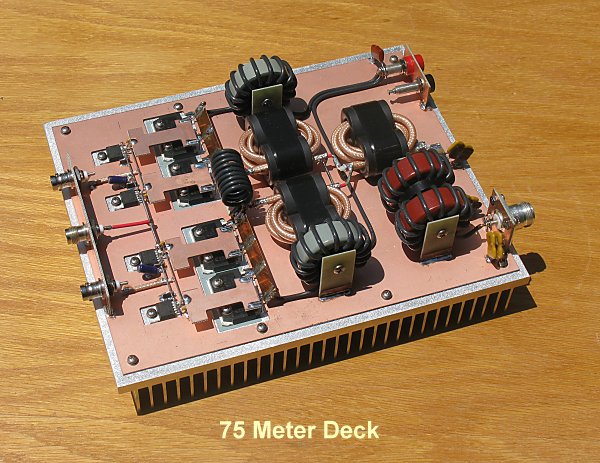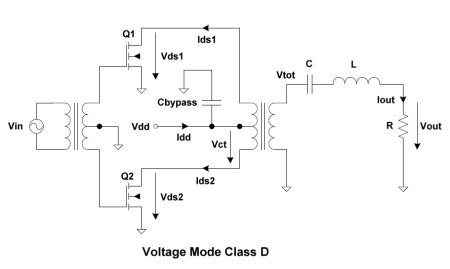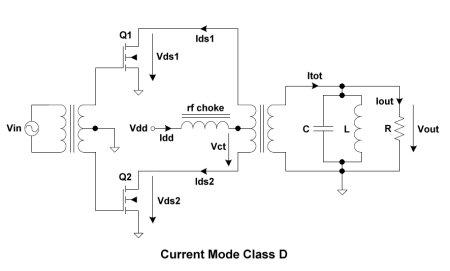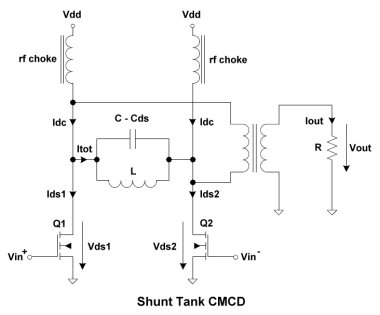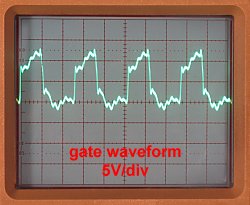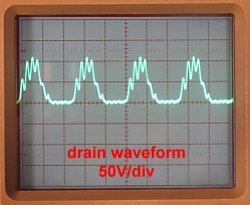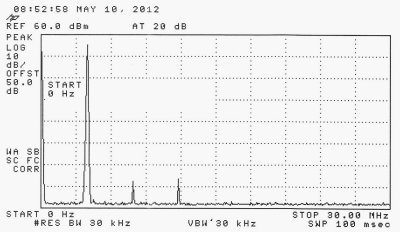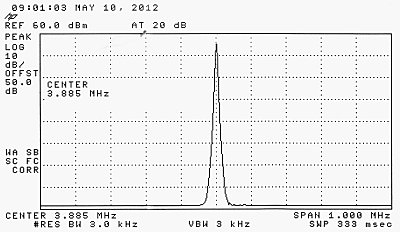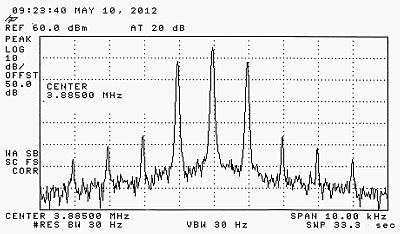|
This is a look at the transmitter modulated by a single 1000 Hz tone. Total harmonic distortion is on the order of a few percent.
|

|
|
|
Results of the 100 Hz triangle test. Additional tests were run using sine, square and triangle waves throughout the transmitter audio passband with excellent results.
|
|
|
Construction Details
Any number of different layouts and construction techniques could likely be used for the CMCD decks, however those shown here have been proven to work. Keep in mind that lead lengths should be kept as short as possible to minimize stray inductance. To this end, mount the drivers ICs close to the FETs and use wide conductors to make the connection. Driver IC ground and FET source pins should be as short as possible. FETs should be mounted as close together as the Silpad insulators permit. This will minimize the width (inductance) of the drain bus. Keep the input/output connections of the transmission line transformers as short as possible. Driver IC 12 volt 'rails' require reasonably heavy gauge wire and should be well bypassed.
The picture below shows the layout.
|
|
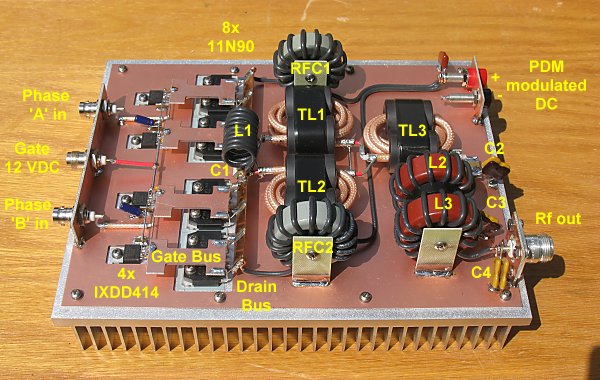
|
|
|
All three decks are built on 8" X 10" X 1-1/4" aluminum heatsinks. Double sided .062" glass epoxy circuit board milled out for the drivers and FETs is attached to the heat sink and provides an excellent ground plane. Drivers ICs bolt directly to the heatsink and the FETs are insulated with Silpad insulators. Additional pieces of circuit board material are used to support the input and output connectors, banana jacks and as supports for the rf chokes and low pass filter inductors. Delrin rod is used as spacers between the circuit board pieces to support the cores. An additional 1/4" delrin 'washer' is used between the two low pass filter inductors to keep them separated. Eventually these decks will be enclosed in rf tight enclosures although there have been no issues operating them in the open.
Most of the construction is fairly obvious but a few things are worth mentioning.
A low impedance driver 12 VDC rail is important because of the high gate capacitance charging current. #16 (or larger) wire should be used and each driver IC should have it's own 0.1 uF ceramic bypass. Large chip caps (1825 size) were used here. Leaded capacitors would also work as long as the leads are kept short. Each rail has it's own electrolytic capacitor.
Driver IC's are connected to the FETs with 3/8" wide conductors. The dogbone shaped pieces of circuit board used here were left over from another project. A single driver IC is capable of driving two FETs on 160 and 75 meters. On 40 meters one driver IC is required for each FET.
The drain buses are made from 1/2" wide copper flashing. C1, the shunt resonator capacitor, is an ATC 100E series capacitor (or two units in series or parallel - see schematic for details) with stripline leads that solder directly to the "A" and "B" phase drain buses. L1, the shunt resonator inductor is soldered to the drain buses on each side of C1.
TL1 and TL2 form the 4:1 transmission line transformer. Each half is wound on two sleeve cores that are taped or epoxied together. As noted on the schematics these are wound with 25 ohm coaxial cable. Only miniature sized 25 ohm coax is readily available so one must construct their own. This is easily done by removing the existing center conductor and insulator from RG-303, RG-142 or RG-400 and replacing it with insulated #14. Stranded wire is best as the winding radius is somewhat tight.
For clarity, the winding count is given as 'passes' instead of turns. A pass is defined as the coax passing through either core. The 5 pass windings fit easily on the cores. The 7 pass windings are a bit of a tight fit.
Operation
The CMCD decks have no tuning and loading controls - only a low pass filter to remove harmonics. This means that the transmitter requires a load fairly close to 50 ohms so that the FETs see the proper drain impedance via the output transformer. Some VSWR (~ 1.5:1) is tolerable and will be seen as a shift in the drain voltage/current ratio. If one normally uses an antenna tuner, this is less of an inconvenience since the load will be close to 50 ohms. In effect, the antenna tuner takes the place of a conventional amplifier tuning and loading controls.
When first powering up the CMCD decks, the shunt tank (C1/L1) should be adjusted for resonance at the center of the band in use. Set the VFO or other signal source to the center of the band and key the transmitter at reduced power (~100 watts output) and spread or compress the turns of L1 for minimum drain current. If a scope is available, verify the drain waveform looks similar to that shown above.
The table below shows the typical operation at the 375 watt carrier level.
|
|
|
|
|
|
|
Band
| Gate V/I
| Drain V/I
| Input Power
| Output Power
| Efficiency
|
|
| | | | |
|
|
| | | |
|
|
160 Meters
| 12.0V/1.5A
| 36V/11.1A
| 400W
| 370W*
| 92.5%*
|
|
| |
|
|
75 Meters
| 12.0V/3.3A
| 35.9V/11.A
| 400W
| 370W*
| 92.5%*
|
|
| |
|
|
40 Meters
| 12.0V/6.0A
| 35.8V/11.2A
| 400W
| 365W*
| 91%*
|
|
* These are approximate values. While it's possible to accurately measure the dc voltage and current input of the transmitter using digital meters, measuring the rf power to the degree of accuracy required for these efficiency levels is much more difficult. Bird 43 wattmeters are usually much better than their 5% FS stated accuracy spec but consider that a 10 watt error (less than half of the rated 5% FS accuracy) results in a 2.5% efficiency uncertainty. Another source of error is the Bird 8327-300 power attenuator, which are known to drift slightly in impedance and attenuation. A more accurate way to measure rf power is being investigated and the numbers presented here will be updated as better measurements are available.
Note the Gate V/I (power) in the table above. This is the power required to drive the gates of the FETS. 160 meters requires 18 watts, 75 meters requires 40 watts and 40 meters requires a whopping 72 watts! This power is dissipated as heat. It's interesting to note that drain dissipation at 92% efficiency is only about 30 watts. As expected, in operation the 40 meter deck gets noticeably warmer. These decks are capable of carrier power beyond 375 watts. Limited testing has been performed at 40 volts/12.5 amps.
Photo below of the 40 meter deck ... same design and layout but with 4 additional driver ICs.
|
|
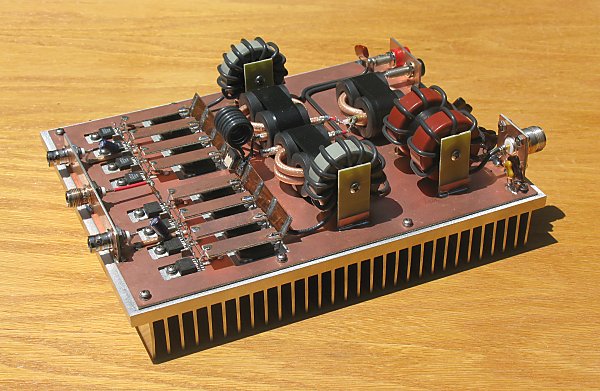
|
|
|
|
| Back to W1VD / WD2XNS home page
|
|
